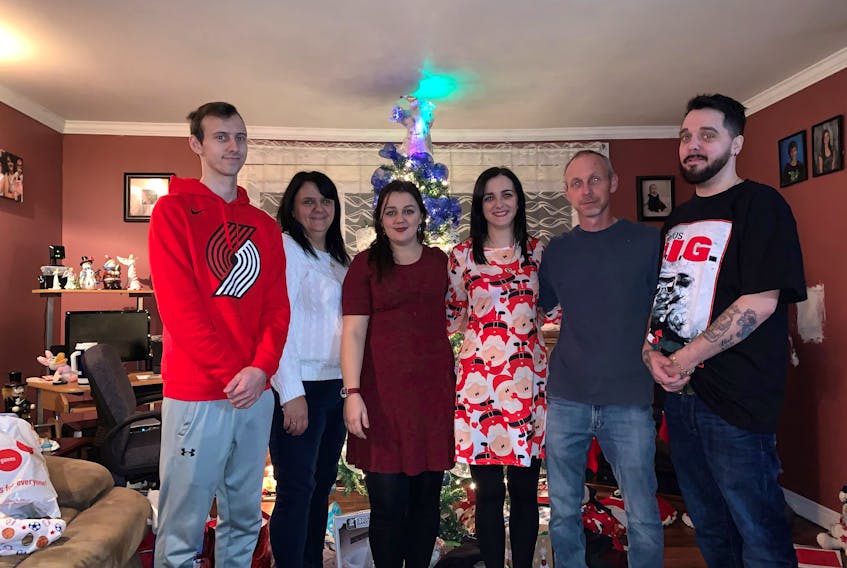On Tibb’s Eve, 2019, Chris James came home with two new lungs.
It was the kind of Christmas gathering his family could only have dreamed of.
Only three months earlier, Chris had been put on a list for a double lung transplant, camping out in Toronto so he could be available for surgery at the drop of a hat.
He and his mother arrived on Sept. 7 and signed the paperwork two days later.
“Five hours later he got his call for his first set of lungs,” said his sister Cassie.

That was unprecedented. Most candidates are on a waiting list for at least six months to two years. Many also receive “fake” calls, where they rush to the hospital only to discover the transplant can’t go ahead for compatibility reasons.
Cassie was ecstatic.
“I hopped on a plane at 5 o’clock in the morning. By the time I got there, he had been in surgery one or two hours,” she said. Her sister followed on a later flight.
When James finally woke up in intensive care, he groggily gave his family a thumbs-up signal. He spent the fall in Toronto recuperating. Cassie went up to visit again in October.
“That week that I spent up there he was just like anybody else out walking the streets of Toronto. He was actually even running, He was running and jumping on things, being a young boy still, a 29-year-old child,” she says with a laugh.
Unfortunately, the Christmas miracle didn’t last.
As December rolled to a close, Chris was suffering pain and having difficulty breathing again. On Dec. 30, he was admitted to the Health Sciences Centre. Doctors there did what they could to limit the damage his own immune system was wreaking on his new lungs.
On Jan. 16 – the day before a record-breaking blizzard hit the Avalon Peninsula — Chris was medevacked back to Toronto. About a month later, still in hospital, he was back on the transplant list.
Genetic defect
Cystic fibrosis is caused by a defective gene. Like most carriers, Chris first started struggling with its effects in his teens. At first, he’d need to visit the hospital once or twice a year for a “tune-up” to clear his lungs. In recent years, he’d be in almost every month. The sticky mucous in his lungs caused a constant cycle of infection and inflammation. Breathing was a chore.
“It’s the most common fatal genetic disease affecting children and young people in Canada,” said Dr. John Wallenburg, speaking by phone from Toronto.
Wallenburg is chief scientific officer for Cystic Fibrosis Canada, and a CF parent.
The genetic defect causes an unusual consistency of mucous in all parts of the body, and can cause other problems such as an inability to digest and absorb food properly.
“The most important clinical impact is in the lungs, where that thick, sticky mucous actually serves as a medium for bacterial growth or fungal growth,” he said.
In the 1960s, Wallenburg said, the survival rate for CF patients was in the single digits. Through advances in drugs and therapy, a child born with the gene in 2018 has about a 50 per cent chance of living to age 52.
“It’s the most common fatal genetic disease affecting children and young people in Canada." — Dr. John Wallenburg
The only treatment for end-stage CF is a lung transplant. In the past three years, six patients from Newfoundland and Labrador have undergone the procedure, including Chris James.
Here’s the kicker.
Miracle drug
A new drug approved in the United States in October holds the potential to radically shift the narrative on CF.
Trikafta is a third-generation drug that can change lives for at least 90 per cent of CF patients. It’s one of a growing category called “precision medicine,” treatments that don’t simply address the symptoms but actually target the defect that causes the disease.
Patients are reporting miraculous relief from complications.
There’s just one problem. It’s not available in Canada. And by the looks of it, it may not be available for some time.

The reason? The drug manufacturer, Vertex, has not submitted the drug to Health Canada’s Patent Medicine Price Review Board (PMPRB). And apparently they’re not the only ones.
“The regulatory pathway in Canada is not good,” says Wallenburg. “PMPRB fixes the maximum price you can sell a drug in Canada. Some changes with that board have put a chill on the pharmaceutical companies. There are a number of companies that have not submitted drugs for Canada at all because of changes to regulations.”
The problem appears to be price. In the U.S., Trikafta costs more than $300,000 annually. That puts a lot of pressure on governments and insurance companies who may be tasked to cover it.
But neither the PMPRB nor Vertex are saying much.
"Vertex has strong concerns that new Canadian medicine pricing reforms have the potential to limit access to treatments for Canadians living with a rare disease,” Vertex said in a statement, replying to emailed questions. “We are working closely with relevant stakeholders to re-envision an environment where access to rare disease medicines for all eligible patients is achievable.”
Health Canada was even more vague:
“If any decisions affecting Canada or Canadian patients are being contemplated by pharmaceutical companies as a result of the PMPRB’s ongoing consultation on new draft pricing guidelines, it would be premature to take them until such time as the document is finalized later this spring to reflect the stakeholder feedback we’ve received.”
The only relief to CF suffers in Canada is coming via a special access program, essentially exceptions on compassionate grounds.
In January, Stephanie Stavros of Pickering, Ont. Became the first person to qualify for Trikafta under the program.
But this is cold comfort for the more than 4,000 Canadians who have to attend specialized treatment centres every year to survive.
Meanwhile, the James family had their prayers answered again Saturday. Chris was matched with another pair of lungs. The surgery took a little longer because of scar tissue on the rejected lungs, but family members were there when he emerged from surgery about half past midnight. Cassie said the doctors were planning to wake him on Sunday.
Peter Jackson is a Local Journalism Initiative reporter covering health care for The Telegram.









